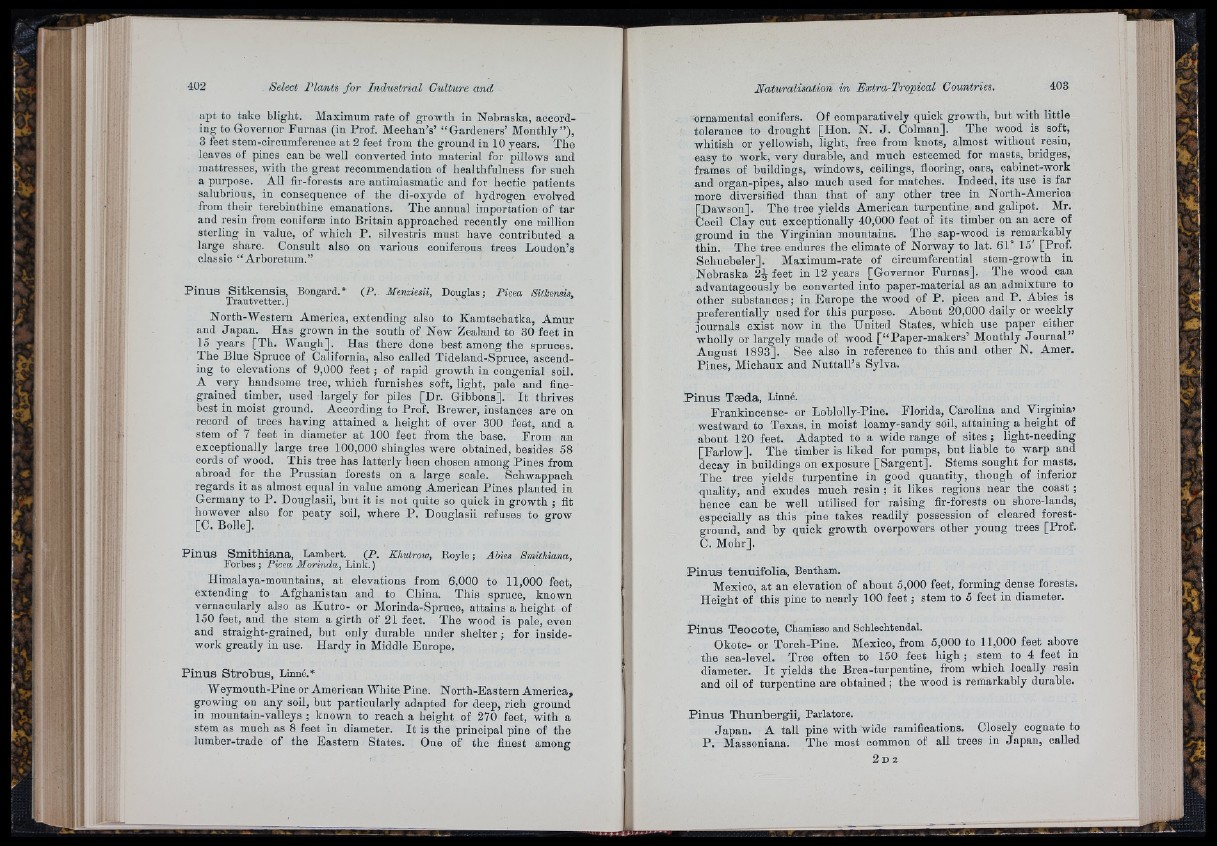
apt to take blight. Maximum rate of growth in Nebraska, according
to Governor Furnas (in Prof. MeehanV “ Gardeners’ Monthly”),
3 feet stem-oircumferenee a t 2 feet from the ground in 10 years. The
leaves of pines can be well converted into material for pillows and
mattresses, with the great recommendation of healthfulness for such
a purpose. All fir-forests are antimiasmatic and for hectic patients
salubrious, in consequence of the di-oxyde of hydrogen evolved
from their terebinthine emanations. The annual importation of ta r
and resin from conifer® into Britain approached recently one million
sterling in value, of which P . silvestris must have contributed a
large share. Consult also on various coniferous trees Loudon’s
classic “ Arboretum.”
Pinus Sitkensis, Bongard.*
Trautvetter. )
{P. Menziesii, Douglas; Picea Sitkensis,
North-Western America, extending also to Kamtschatka, Amur
and Japan. Has grown in the south of New Zealand to 30 feet in
15 years [Th. Waugh], Has there done best among the spruces.
The Blue Spruce of Ca ifornia, also called Tideland-Spruoe, ascending
to elevations of 9,000 feet ; of rapid growth iu congenial soil.
A very handsome tree, which furnishes soft, light, pale and finegrained
timber, used largely for piles [Dr. Gibbons]. I t thrives
best in moist ground. According to Prof. Brewer, instances are on
record of trees having attained a height of over 300 feet, and a
stem of 7 feet in diameter at 100 feet from the base. From an
exceptionally large tree 100,000 shingles were obtained, besides 58
cords of wood. This tree has latterly been chosen among Pines from
abroad for the Prussian forests on a large scale. Schwappach
regards it as almost equal in value among American Pines planted in
Germany to P . Douglasii, but it is not quite so quick in growth ; fit
however also for peaty soil, where P . Douglasii refuses to grow
[C. Bolle]. ^
Pinus Smithiana, Lambert. {P. Khwtrow, Royle; Abies Smithiana,
Forbes ; Picea Morinda, Link. )
Himalaya-mountains, at elevations from 6,000 to 11,000 feet,
extending to Afghanistan and to China. This spruce, known
vernacularly also as Kutro- or Moriuda-Spruce, attains a height of
150 feet, and the stem a girth of 21 feet. The wood is pale, even
aud straight-grained, but only durable under sh e lte r; for inside-
work greatly in use. Hardy in Middle Europe.
Pinus Strobus, Linné.*
Weymouth-Pine or American White Pine. North-Eas tern America,
growing on any soil, but particularly adapted for deep, rich ground
in mouutaiu-valleys ; known to reach a height of 270 feet, with a
stem as much as 8 feet in diameter. I t is the principal pine of the
lumber-trade of the Eastern States. One of the finest among
ornamental conifers. Of comparatively quick growth, hut with little
tolerance to drought [Hon. N. J . Colman]. The wood is soft,
whitish or yellowish, light, free from knots, almost without resin,
easy to work, very durable, and much esteemed for masts, bridges,
frames of buildings, windows, ceilings, flooring, oars, cabinet-work
and organ-pipes, also much used for matches. Indeed, its use is far
more diversified than that of any other tree in North-America
[Dawson]. The tree yields American turpentine and galipot. Mr.
Cecil Clay cut exceptionally 40,000 feet of its timber on an acre of
ground in the Virginian mountains. The sap-wood is remarkably
thin. The tree endures the climate of Norway to lat. 61° 15' [Prof.
Schuebeler]. Maximum-rate of circumferential stem-growth in
Nebraska 2L feet in 12 years [Governor Furnas]. The wood can
advantageously be converted into paper-material as an admixture to
other substances; in Europe the wood of P . picea and P. Abies is
preferentially used for this purpose. About 20,000 daily or weekly
journals exist now in the United States, which use paper either
wholly or largely made of wood [ “ Paper-makers’ Monthly Jo u rn a l”
August 1893]. See also in reference to this and other N. Amer.
Pines, Michaux and Nuttall’s Sylva.
Pinus Tæda, Linné.
Frankincense- or Loblolly-Pine. Florida, Carolina aud Virginia’
westward to Texas, in moist loamy-sandy soil, attaining a height of
about 120 feet. Adapted to a wide range of sites ; light-needing
[Farlow]. The timber is liked for pumps, but liable to warp and
decay in buildings on exposure [Sargent]. Stems sought for masts.
The tree yields turpentine in good quantity, though of inferior
quality, and exudes much resin ; it likes regions near the coast ;
hence can be well utilised for raising fir-forests ou shore-lands,
especially as this pine takes readily possession of cleared forest-
ground, and by quick growth overpowers other young trees [Prof.
C. Mohr].
Pinus tenuifolia, Bentham.
Mexico, a t an elevation of about 5,000 feet, forming dense forests.
Height of this pine to nearly 100 feet ; stem to 5 feet in diameter.
Pinus Teocote, Chamisso and Schlechtendal.
Ckote- or Toroh-Pine. Mexico, from 5,000 to 11,000 feet above
the sea-level. Tree often to 150 feet h ig h ; stern to 4 feet in
diameter. I t yields the Brea-turpentine, from which locally resin
and oil of turpentine are obtained ; the wood is remarkably durable.
Pinus Thuntaergii, Parlatore.
Japan. A tall pine with wide ramifications. Closely cognate to
P . Massoniana. The most common of all trees in Japan, called
2 D 2